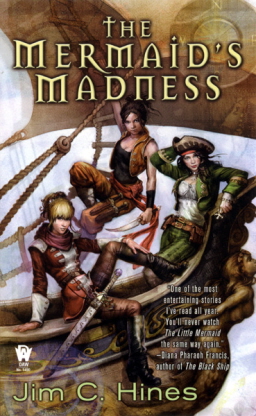Book Review: Jim C. Hines’ The Mermaid’s Madness
 The Mermaid’s Madness
The Mermaid’s Madness
Jim C. Hines
DAW (339 pp, $7.99, 2009)
Reviewed by Andrew Zimmerman Jones
Jim Hines has developed a name for himself by taking traditional fantasy and warping it into a twisted, entertaining, and amusing adult fantasy storyline. His first series, the Jig the Goblin Trilogy (Goblin Quest, Goblin Hero, and Goblin War), took traditional roleplaying game fantasy clichés – complete with a dwarf who is obsessed with mapping out the dungeon the protagonists are crawling – and turns it on its ear by making a goblin the hero of the series.
In his Princess Novels, he has taken the three classic princesses of fairy tales – Cinderella, Snow White, and Sleeping Beauty – and turned them into a trio of bad-ass fantasy heroines. (You may insert your own Charlie’s Angels comparison here.)
Snow and Talia (i.e. Sleeping Beauty) are living in exile, serving Queen Beatrice – the mother of Cinderella’s prince charming, Armand – as a sort of secret agent squad. Snow is a sorceress, with an emphasis on mirror-based magic. Talia is basically a weapon expert and all-around combat machine.
The major characters are established in the first book of the series, The Stepsister Scheme, which is basically a darker retelling of the story of Cinderella (her real name in the novel is Danielle). There the three princesses team up to rescue Armand from Cinderella’s stepsisters.
The Mermaid’s Madness, the second book in the series, is a retelling of “The Little Mermaid,” but of course with the requisite dark twists and turns. I won’t go into many details of the storyline, to avoid spoilers. The mermaid Lirea is totally insane (thus the title) and trying to start a war. After murdering her father, her next move is to steal Queen Beatrice’s soul. The plot twists are well paced throughout the book, offering a consistent mutation of the original tale. Most impressively, all of the character motivations – even those of the insane characters – make sense from their point of view.
While the plot is enjoyable, the real charm of the book is the dynamic between the main characters.
In fact, I guess it’s confession time – I have never actually read the first book. Despite that, I had no problem immediately getting up to speed with the setting, the characters, or their internal relationships. By building on the framework of existing fairy tales, Hines has a natural structure upon which to add his permutations.
And the permutations are dark, in ways that bring modern sensibilities to bear on these classic tales. Each of these princesses has been abused – abused by parents (or step-parents), sisters, lovers – and the wounds are apparent in this version of the story. This abuse forms the basis of the empathy and friendship between them.
While the tale is pretty dark, Hines does a great job of keeping it from overtaking the rest of the narrative. The story is also filled with genuine humor, wit, and levity. It is a tough job to mine this familiar material without seeming clichéd – or like you are ripping off Shrek – but these problems were avoided in this story. All of the components of the novel worked well together … well enough that it makes me look forward to reading Red Hood’s Revenge (2010) and The Snow Queen’s Shadow (2011), to see how Hines transforms some other classic tales.
Books by Jim C. Hines:
- Jig the Goblin
- Princess Novels
- Kitemaster and Other Stories (short story collection – ebook only – Amazon, B&N)
- Libriomancer (coming in 2012)
- the short story that inspired the novel, “Mightier Than the Sword,” originally appeared in the anthology Gamer Fantastic, reviewed in Black Gate #14, and is reprinted in Goblin Tales
- the first chapter is available in the Kitemaster collection
This review comes from the pages of Black Gate #15. The book was provided by the publisher for review purposes. It has been updated to take into account publication of books since it was written.
Andrew Zimmerman Jones is a writer of fiction and non-fiction. He has been a finalist in the Writers of the Future contest and received Honorable Mention in the 2011 Writer’s Digest Science Fiction/Fantasy Competition. In addition to being a contributing editor to Black Gate magazine, Andrew is the About.com Physics Guide and author of String Theory For Dummies. You can follow his exploits on Facebook, Twitter, and even Google+.